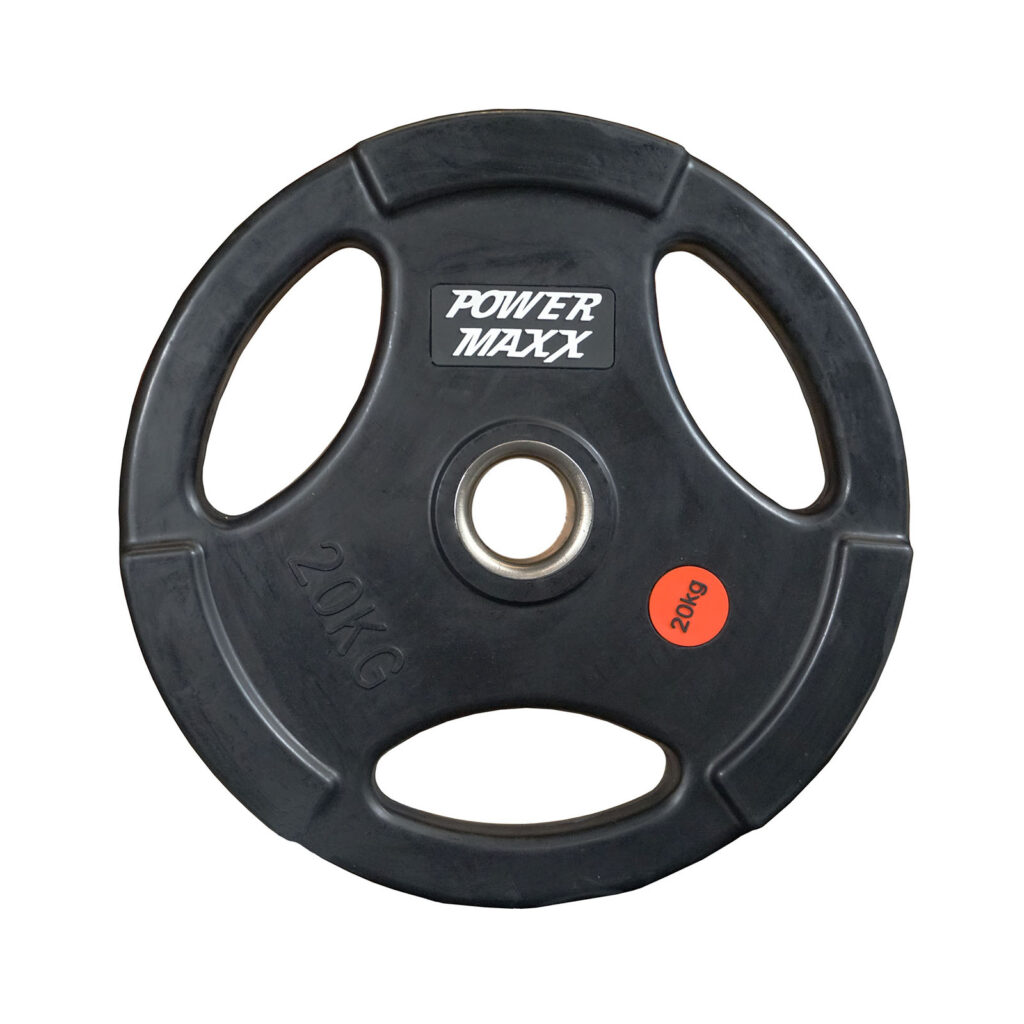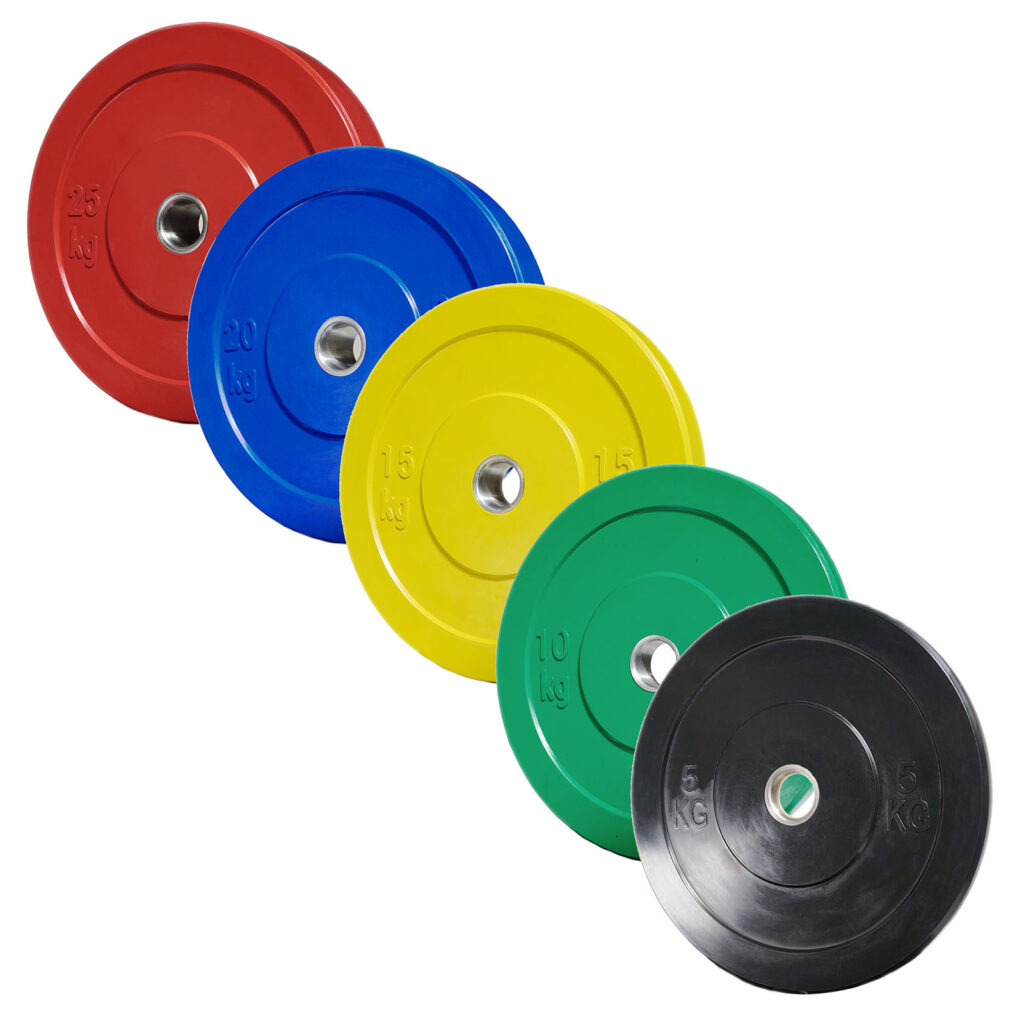Weight Plate Buying Guide
Whether you are new to weight training, or have been lifting for years, the range and variety of weight plates has exploded over the recent years. As an experienced trainer myself, making the right choice for plates is daunting. Plus, the affordability of premium styles has improved dramatically, making the decision harder.
What I thought it would be a good idea to break down the specs of the different varieties, so you can work out what type of plate would best suit your gym.
Black Olympic Rubber Coated Plates
These weight plates are made out of cast iron and coated with rubber. They are designed to prevent rusting, plate clattering and damaging your floor.
You will find them in most commercial and home gyms. Simply because they are cheap, and they get the job done.
They come with handles which makes them extremely easy to change, especially on plate loaded leverage machines – having handles on a 25kg plate makes it a lot easier to get on and off a leverage squat machine.
Why are these plates the cheapest? The simple answer is because they are the most basic. If you are planning on getting into serious powerlifting, weightlifting or crossfit you will require speciality plates of some sort.
These plates are not designed for heavy and repeated dropping, but if you don’t plan on doing that, then they are all you really need.

Also they aren’t calibrated to the same degree as the higher end plates. This means they have a wider variance to their stated weight. If you are getting into serious competition – not a ‘manhood’ measuring bench press battle at the local pub – I mean entering into powerlifting competitions with the intention of breaking records then look at higher end plates.
I trained with these basic style plates and have won competitions and switched to the ATX Powerlifting Plates when training for the World Bench Press Championship.
Power Maxx Premium Rubber Coated Plates
Compared to regular Black Olympic plates they are slightly thicker and more visually appealing. The Power Maxx Logo and incapsulated weight numbering will stick out and give your gym a smart look.
These plates are thicker in width than normal plates, but this is partly offset by the fact that they partially interlock. If you want to load up a leg press for example and you had limited weight loading space, then go for a thinner style plate.
For some people, aesthetics in their gym is important, they like to pimp it up a bit, so these are a cost-effective way to do this without going to the more extreme plates that are on offer.

Power Maxx Premium Rubber Coated Plates
Olympic Weightlifting Weight Plates are 450 mm in diameter and comes in either all black or colour coded versions.
Plate colours by weight:

The colour coding system was designed for competitions to make it easier for spectators and loaders to know what weight the athlete is lifting.
The solid bumpers come in plain black too, so if you don’t need the colour coding system you can save yourself some money. Buying bumper plates all in black is cheaper as there are fewer manufacturing costs.
These solid rubber bumpers are entry level bumper plates. Over the years the price of these has reduced dramatically making them very affordable for even the most budget conscious home gym enthusiast.
They absorb shock way better than the basic rubber coated cast iron plates. Plus, the solid rubber absorbs shock. This will reduce wear and tear on your barbell, weight plates and gym floor.
The other big advantage is that all the plates are 450mm in diameter. This will get you at the right height for all your weightlifting or powerlifting exercises. For you inexperienced lifters, this means the barbell will be at the standard height.
Some weight plates have a lot smaller diameter. This means the barbell will be lower to the ground and harder to lift heavier weights off the ground.
The downside to these bumpers is that they are much thicker than most plates. This is only a problem if you are starting lift extremely heavy – you will run out loading area on your barbell. This can be easily overcome by buying some extra 20kg Olympic rubber coated plates above.
Or you can add ATX Powerlifting plates mentioned later.
Also, the 5kg & 10kg weight plates aren’t designed for using individually for dropping. By this I mean loading one 5kg or 10kg plate either side, then dumping the bar from a great height. Remember these plates are made from solid rubber, so the 5kg & 10kg plates are thinner and when rubber is too thin it doesn’t have a lot of support.
But they are ideal for working on technique, so if you are doing this, you don’t need to dump the bar down hard.
Premium Competition Bumper Plates
Power Maxx Premium Bumper Plates are one of the thinnest ones on the market. They combine the best of both worlds, the shock absorption of solid rubber plates with a thin diameter associated with steel plates.
This is achieved is by using a solid steel core embedded into a solid rubber plate, allowing the manufacturer to reduce the thickness of the plate by around 40%! It makes them a better option for the serious lifter who will max out the loading area of the barbell using solid rubber plates.
They have successfully passed the 10,000 drop test, which makes them perfect for any commercial gym or weightlifting enthusiast. For those of you who like a bit of bling, the solid steel core and lettering certainly add to the visual appeal of these plates.

Powerlifting Plates – Classic Thin Cast Iron Discs.
The ATX Powerlifting Plates are designed for the trainer who is serious about their lifting. If you have entered a few powerlifting comps and have been bitten by the bug, then it might be time to upgrade your equipment.
These plates have the same specs of the plates that you will be using in competition, but at a fraction of the price.
The reason these plates are more expensive than other weight plates is that they are made to exacting tolerances – they have a weight variance of +/-0.5%.
The contact areas are chrome plated. Chrome is extremely durable, so it is ideal for areas which experience metal on metal contact. Painted plates will chip, so over time this will affect the weight variances.
The other advantage is that they are extremely thin. You can load a lot of weight onto your barbell. This also makes them handy for plate loaded machines like leg presses where you sometimes run out of loading area.
Like Olympic Bumper Plates, powerlifting plates are lacquered in Olympic Colours.
- 25 kg – Red (26 mm)
- 20 kg – Blue (22 mm)
- 15 kg – Yellow (21 mm)
- 10kg – Green (21 mm)
- 5kg – White (18 mm)

Just like weightlifting plates they come in the same diameter – 450 mm.
Unless you need them for powerlifting or a leg machine, I wouldn’t advise these for general gym use. Let’s face it, these plates are sexy! But this sex appeal does have its draw backs.
As the plates are extremely thin and chrome plated, they are sometimes hard to grip. Inexperienced trainers will find them heavy, so this combination makes loading plate loaded machines difficult. Especially taller machines like leverage squats.
If you are a home weight trainer and want to sneak in a workout before work while the family sleeps then steer clear. These plates make a racket when deadlifting. For some the clang of iron plates is music to their ears, but not when you get woken up at 5am!
Fractional Plates
Both weightlifters and powerlifters use fractional plates. It is handy to have some smaller plates laying around in your gym. Adding 10 kg on the bar is not an extremely efficient way to train.
Made out of solid steel. Offers minimum weight deviation. It allows the lifter to train closer to his or hers personal best without having to risk a failed repetition via massive jumps in weight.
Fractional plates are available in:
- 5 kg
- 2.5 kg
- 1.25 kg
- 1 kg
- 0.75 kg
- 0.25 kg
- 0.5 kg

You can also buy them in sets such as our Power Maxx 5kg Fractional Plate Set that comes with a pair of 0.25kg, 0.5kg, 0.75kg & 1kg plates.
The best way to beat your PB’s is to sneak up on them. Half the battle of lifting heavy is psychological, increasing with small amounts breaks down this barrier.
Calibrated Plates
Calibrated weight plates are used for competition. They come with lead inserts and offer minimal weight deviation of 0.05%. The inserts allow you to dial in your plates to the exact weight.
These plates are not certified by the appropriate federations for sanctioned events. These are the events where records can be broken and officially recognised. But they are a lot cheaper than the ones that are certified.
This makes them ideal for the gym who is either preparing competitors for sanctioned events or want to put on an unsanctioned event.
ATX calibrated plates come in following thickness and colour:

A Word on Weight Variances….
All weight plates vary – the degree will depend on their quality and cost. Now, before you go and grab your 20 year old bathroom scales, I should add that the same applies to scales.
Just like plates, they vary too. Therefore, it doesn’t make sense to calibrate expensive plates on el cheapo scales.
Proper calibration requires proper equipment.
Ultimately for the average to advanced weight trainer, variances aren’t going to make or break your training dreams – especially if you are not specifically training for competitive weightlifting or powerlifting.
In my native Lithuania, we trained with whatever we could get our hands on. We were happy to have anything heavy to lift and never thought to ever check for variances. We would gauge our strength gains by lifting more of whatever we had. I suggest you do the same.

